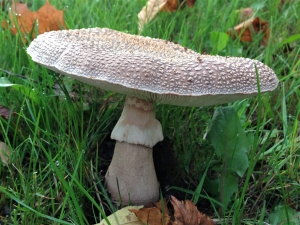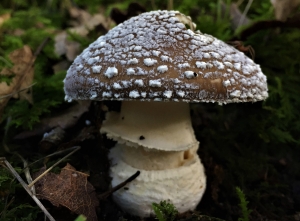The Blusher is a mushroom often overlooked because of its similarities to the Panther Cap. The Blusher itself is a very tasty mushroom, and does not need to be boiled, as you will see recommended on most websites, but it does need to be thoroughly cooked.
There are enough differences between the Blusher and the Panther Cap for the diligent mushroom hunter to feel safe in their identification in most cases. I insist though that unless you are sure that you have a blusher do not eat it as the Panther Cap is a potentially Deadly mushroom. They can also grow in close proximity so do not assume because you have found a patch of mushrooms that they are all the same. Identify each one individually using the guidelines below and throw away any you are unsure of.
Below you can see examples of both mushrooms. The Panther Cap on the right and The Blusher on the left.

 Superficially these mushrooms can look almost identical. The Blusher, on the left, would have started with the flaky covering all over the mushroom. These flakes are one of the many ways you can tell the difference; all of these are listed below.
Superficially these mushrooms can look almost identical. The Blusher, on the left, would have started with the flaky covering all over the mushroom. These flakes are one of the many ways you can tell the difference; all of these are listed below.
Beware! Unless you are 100% sure that you have a Blusher, DO NOT EAT IT or you may poison yourself. This is not an idle threat, there are numerous cases of Panther Cap poisoning!
Do not pick these mushrooms when they are very young, as there is far more chance of making a mistake.
Do not eat the Blusher Raw! There are toxins in it which must be cooked out!
So how do you tell the difference between the Blusher and the Panther Cap?
 1. The Caps are coloured slightly differently. The Blusher is paler and gets lighter closer to the outer rim, whereas the Panther Cap is a darker chestnut brown and is either consistent in colour or becomes darker. The Blusher cap is the top photo.
1. The Caps are coloured slightly differently. The Blusher is paler and gets lighter closer to the outer rim, whereas the Panther Cap is a darker chestnut brown and is either consistent in colour or becomes darker. The Blusher cap is the top photo.
2. The scales on the Blusher are movable and often inconsistently arranged. The Panther Cap spots are less scaly and more like a calcite build up. They do not move so easily and they should be  pure white (though they do get dusty or muddy) whereas the scales on the Blusher are brown or grey.
pure white (though they do get dusty or muddy) whereas the scales on the Blusher are brown or grey.
3. The base of the mushrooms are different. There is often the remains of a discernible sack or Volva, looking a bit like a cup or acorn holder, from which the Panther cap grows, the Blusher has a more bulbous base. The Blusher, again, is on top in the adjacent photos.
 4. The veil or skirt. The skirt of the Blusher is pendulous, hanging down a bit like a pleated A-line skirt with striations, or grooves, running vertically down the skirt, which can be a couple of centimetres long. The skirt of the Panther Cap is not so pendulous, does not have the striations and is smooth on top; this is an important identifying feature.
4. The veil or skirt. The skirt of the Blusher is pendulous, hanging down a bit like a pleated A-line skirt with striations, or grooves, running vertically down the skirt, which can be a couple of centimetres long. The skirt of the Panther Cap is not so pendulous, does not have the striations and is smooth on top; this is an important identifying feature.
5. The stem of the Blusher is often more grey and stains pinky red when cut or on bruising.  The Panther Cap stem is white and remains white when bruised and can often be hollow in older specimens.
The Panther Cap stem is white and remains white when bruised and can often be hollow in older specimens.
6. The gills of the Blusher are not crowded and again spots or red stains can be seen on the gills on bruising. The gills of the Panther Cap do not bruise and are crowded.
7. The habitat of both mushrooms is similar, in both broad-leafed and coniferous woodland, though the Panther Cap does have a slight preference for Beech.
The habitat of both mushrooms is similar, in both broad-leafed and coniferous woodland, though the Panther Cap does have a slight preference for Beech.
8. The Spores of both mushrooms are white. You would need a microscope to tell the difference.
Related pages



Leave a Reply